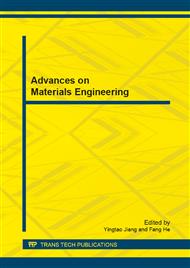p.151
p.156
p.161
p.166
p.173
p.180
p.186
p.191
p.199
Synthesis and Properties of Superparamagnetic Fe3O4 Nanoparticles by Co-Precipitation Process
Abstract:
Superparamagnetic Fe3O4 nanoparticle with single phase has been synthesized successfully by a co-precipitation process. On the other hand, the effect of additive anhydrous ethanol in synthesis procedure was investigated for the magnetic properties of nanoparticles in this paper. The structure properties of synthetic Fe3O4 particle were measured through XRD, FT-IR and TG-DSC devices. The characteristic peaks of Fe3O4 have been observed to testify Fe3O4 with single phase. The particle size and shape were observed by SEM and TEM measurements. The addition of anhydrous ethanol could enhance the dispersion of Fe3O4 nanoparticles and restrain the agglomeration of nanoparticles. Therefore, the average particle size was about 18.2 nm, smaller than that of Fe3O4 particles prepared without anhydrous ethanol of 24.3 nm. Correspondingly, the saturation magnetization (Ms) of Fe3O4 prepared with and without anhydrous ethanol was determined to be 53.28 emu/g and 65.28 emu/g, respectively, lower than bulk magnetite particles of 90 emu/g. That is because, synthetic Fe3O4 with smaller particle size obtains the higher surface curvature, which could enhance the disordered crystal orientation on the particle surface, so the saturation magnetization was decreased.
Info:
Periodical:
Pages:
173-179
Citation:
Online since:
August 2013
Authors:
Price:
Сopyright:
© 2013 Trans Tech Publications Ltd. All Rights Reserved
Share:
Citation:


